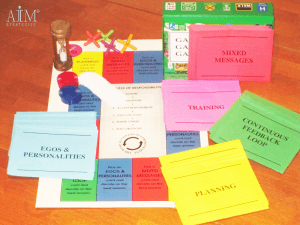Interview with Virtual Work Teams Expert Yael Zofi
This is a continuation of the interview with Yael Zofi on virtual work teams:
Q. In the previous post you reflected on the ASTD Tech Knowledge conference you attended and presented last month. Jane McGonigal was one of the keynote speakers you found interesting. To continue from where we left off earlier this week, I wanted to ask a few more questions:
Jane talked about the powerful positive emotions people show while playing games and how to bring this concept to real lives and workplaces. What is your take on this as a Management Trainer and Human Capital Consultant? Do you think gamification can be applied successfully in workplaces? How would you apply it, and have you ever applied the gamification concept in virtual work teams?
A. Back in the day when I used to run onsite training sessions, particularly around giving and receiving feedback, we created a board game called The Roadmap for Continuous Improvement. Participants had to give feedback in real-time. Because this occurred about 20 years ago, it was not an online activity.
Today, the combination of technology and human connection brings a huge opportunity. Organizational training games can be designed by a team to produce a technical piece, an organizational piece and a simulation piece. Since delivery is mostly virtual, the core concept must at its core be about keeping people engaged on virtual work teams.
Therefore the key point I’d like to make is that every virtual work teams building game needs to combine the best of technology and organizational development, so that the product accomplishes what it was meant to do – create a virtual community.

A. Stewart Crabb shared Facebook’s history and the importance of the Social Graph – people and the connections they have to everything they care about.
Stewart indicated that people constantly look for any opportunity to share and connect, which is very much the core premise of my virtual work teams book. Virtual or not, you still need to create a human connection with people. Another interesting moment in Stewart’s Keynote was when he referred to Facebook as a social ‘container’ allowing for collaboration, wisdom and community. Facebook’s growth has been exponential and they are extremely popular with Generation Z, also known as Generation I. People have a natural need to connect, and Facebook has become the social hub for millions. It stands to reason that there is a huge opportunity for using Facebook as a learning platform.
Q. Do you have any final points or a message to your readers?
A. Sure. To finish, I think the world of global learning and development will move with increasing speed to utilize technology. In the coming years we will join online communities which are designed by engineers who need to address the people side of technology. After all, training is about building bridges between people, and when people connect virtually there are many considerations, such as behavior, emotions, skills, communication, management, and all the human characteristics that make us personal. That is why, in order to succeed in virtual business and e-training environment, we have to think in terms of community, and consider what it means to become a “friend” in the newest sense of the word.




